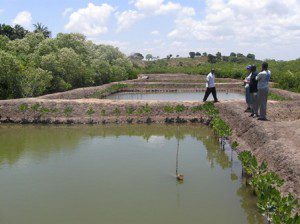By Shawn Peabody, Madagascar Locally Managed Marine Area (LMMA) Coordinator.
I travelled to Mombasa, Kenya last week to attend a workshop developing a proposal to investigate the role that marine ecosystem services play in poverty alleviation around the Indian Ocean. We’re working with a number of partners from around the region, and were hosted by our friends and colleagues at the Mombasa-based conservation group CORDIO (Coastal Oceans Research and Development in the Indian Ocean- http://www.cordioea.org/).
Whilst in Kenya we were fortunate enough to visit Kwetu (http://www.kwetukenya.org/), a community training centre just a few miles outside of the city, located on a hilltop next to mangrove creek (http://www.kwetukenya.org/mariculture/index.html). Kwetu trains local residents in sustainable livelihoods including beekeeping, candle-making, and aquaculture (milkfish and crabs). The aquaculture interested us the most as we have two aquaculture projects currently underway in the Velondriake region and were eager to learn from Kwetu’s experiences.
The aquaculture site is located a couple hundred meters from the brackish river. There are a number of sites in the area, the two sites that we saw consisted of approximately 10 ponds dug 2 meters down into the salt flats at the upper margin of the mangroves. A channel runs between the ponds and is fed from a pipe that allows for partial water exchange at high tide on the spring tides. Mangrove seedlings were planted around each of the ponds to provide shade, nutrients for the fish and protect against erosion.
Milkfish and mullet are stocked in the ponds, and prevented from swimming out of the tidal water feeds by nets. These fish are filter feeders, hoovering up algae and material in the water column. They only need minimal feed input, since algal growth in the water is rapid, although communities add feed made from local agricultural waste and rice husks. The milkfish have a better growth rate and so are preferred by the farmers but they are having trouble finding juveniles (all fished in the local mangrove creek) so production is limited. Fingerlings of both species are caught in small mesh nets in the mangroves then put in a holding pond for a few weeks until they grow big enough for proper identification (it’s evidently hard to identify species when they are so small) when they are all released except for the milkfish and mullet. Putting the wrong species in the pond can result in disaster as one or two predators can eat their way through a large chunk of the stock of a pond in just a few weeks.
Despite several years of experience, these impressive farming basins have so far only had limited commercial success. Production is far lower than hoped due to predation, pond failure (erosion of pond walls), and disease. One farmer group that we met had recently sold 130 kilos of fish but the earnings barely covered their expenses on feed. The Kwetu technicians said that their top research priority is to find alternative, lower-cost feeds as well as finding a way to produce milkfish juveniles in large quantities.
In addition to fish aquaculture, Kwetu is also working on crab fattening. Wild, juvenile mangrove crabs are caught and placed in suspended bamboo cages in the fish ponds. The crabs are fed daily with fish waste and after just a few months they are big enough for market. Crabs are held individually in the cages, to avoid the risk of fighting, which, we were told, would otherwise result in loss of pincers – the most valuable part of the crabs.
This project is low-tech, low-risk and potentially very lucrative. Kwetu is still in the testing phase for this, but have already raised several generations of crabs to maturity. Al, Blue Ventures’ Research Director (http://blueventures.org/), and I hope to bring this idea back to Velondriake for a trial as crabs are the third largest export commodity in the region (after octopus and squid). We don’t yet have hard numbers, but from what we’ve heard from the largest seafood collection company in the region, western Madagascar’s mangrove crab fishery is in sharp decline, likely as a result of overexploitation. Perhaps Velondriake (http://www.livewiththesea.org/) can use crab fattening to generate income for local fisherman while also replenishing the brooding stock (by returning a portion of the mature females to the wild).
Overall, it was fascinating to see community aquaculture projects in another area of the western Indian Ocean. As with our own aquaculture projects in Madagascar, there still remain a number of important technical and economic challenges. However, like our own community partners, the farmers and technicians of Kwetu are highly motivated and committed to solving the problems they face, and bringing about a revolution in sustainable coastal livelihoods and resource management.




is good place that promote development,innovation and employment opportunities